John Hurrell – 17 February, 2023
The idea of testing the onlooker appealed to Nixon, for the notion of ‘monochrome' to this artist did not necessarily mean a purely uninterrupted plane of chroma, as the presence of centrally positioned black discs or narrow brown Masonite bands on the lower edges here testify. He is playing with our expectations, undermining the conventional notion of planar extension—through discreet minimal insertion. Questioning maybe our trust in the language of titles.
Auckland
John Nixon
Works 1990 - 2014
Curated by Sue Cramer
10 February 2023 - 11 March 2023
In this carefully positioned selection of non-objective paintings at Two Rooms (see individual works here) by the late, extraordinarily inventive and prolific, Australian artist John Nixon—works from his long running Experimental Painting Workshop (EPW) that focus on combining formal material properties such as chroma, extension, temperature, proportion, saturation, shape, and texture from method of paint application—we see his later ‘visual’ preoccupations, and not the overtly poetic (political, psychological or narrative) elements such as crushed eggshell or glued on grains of wheat that came before.
Many of these works have cut-out painted mdf geometric shapes glued onto painted mdf panels that lie flat on the wall, unlike say canvases. The method is a way of emphasising the idea and devaluing laborious time-consuming manual skill. It has a political anti-craft dimension.
Although making hard-edged or monochromatic paintings was a crucially dominant activity (his earlier works showed an infatuation with Suprematism and Constructivism) there were many other aspects to Nixon’s methodical art investigations (often with collaborators), such as collage, installation, writing manifestos (Pneumatic Drill), printmaking, performance (The Donkey’s Tail), photography (The Society for Other Photography) and sound (Anti-Music).
Sue Cramer, his widow and director of his estate, a highly regarded freelance curator herself, has organised a vibrant orchestration of rectangular or square painted mdf panels that revolve around Nixon’s passion for the hot colour orange—he bought different brands of enamel orange in the different countries he visited—and often utilised in the form of glowing monochromes, here carefully spaced apart on the walls at regular intervals. Only one stretched canvas is included, a tilted square (diamond) monochrome at odds with the alignment of the rest of the show.
Sometimes Nixon’s exhibitions in the past have had too much work, stretching the viewer’s attention span and causing exhaustion, but this posthumous show of a dozen items has been pitched perfectly by Cramer. It has much subtlety within the many (albeit obsessive) variations, and leaves you wanting more. But not too much.
In some of these twelve works of abstract geometry, painted bands of pale grey almost merge with the supporting gallery wall, cutting ‘holes’ into the painting’s picture plane structure; in others diagonal strips of layered mdf obscure parts of ‘ostensibly doubled’ multi-coloured panels (polychromes) with horizontal coloured bands of different lengths. Teasing the viewer through what is hidden; what is revealed.
The idea of testing the onlooker appealed to Nixon, for the notion of ‘monochrome’ to this artist did not necessarily mean a purely uninterrupted plane of chroma, as the presence of centrally positioned black discs or narrow brown Masonite bands on the lower edges here testify. He is playing with our expectations, undermining the conventional notion of planar extension—through discreet minimal insertion. Questioning maybe our trust in the language of titles.
Nixon‘s small block paintings (of which there is one pale blue example), with their textures of thick hessian coasted with glossy enamel, not only dramatically project out from the gallery wall but dominate the architectural space out of proportion to their actual size. As simple compacted paintings where the depth is a third of their width and height, they exude dignity and rigor in a way that dominates over other much larger and more complex objects.
His painted ‘conversations’ with other much earlier modernist artists (such as seemingly Victor Vasarely, Auguste Herbin, or Luis Martinez-Pedro) were like that of the ‘homage’ approach of the much older NZ painter Gordon Walters, in that the ‘visited’ artist’s works are referenced and altered with Nixon’s own colouring and ordering sensibility—that happened at that time to be jewel-like.
One might speculate that Nixon‘s adoration of orange came from memories of the heat metaphorically connected to the earlier values espoused by the much younger avant gardist ‘firebrand’ he once was, who once wrote lines like I spit upon the altar of art in EPW manifestos. It is an incendiary colour, beautiful but linked to destruction—though from the ashes a phoenix rises. But that might be over intellectualising, and underplaying the value of intuition and viscerality.
The longest wall in this show has five carefully positioned, identically sized squares: three monochromes, and two polychromes with thick bands of horizontal colour, one of the latter (Untitled, 2001) having two bands of right-angled Ls that wrap around an enclosed orange square tucked in a bottom corner. Organisational context is everything, and here orange is compressed and contained, never liberated.
In other larger rectangular monochromatic works such chroma hovers and breathes, but here with this work (see second image) the small warm coloured square is squeezed via parallel vectors on two sides, uneven pressures nudging it away from its top righthand corner to the lower left, where its perimeters are untrammelled, unfenced. The two mdf edges that rest on the wall have accompanying skinny shadows, very different from the thick painted L-shapes (positive and negative) lurking above. A faint and delicate whisper persists; a pale murmur of wavering but insistent substantiality.
John Hurrell

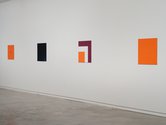
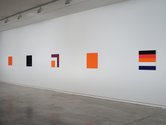
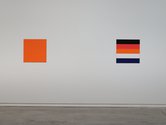

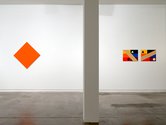
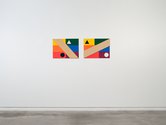
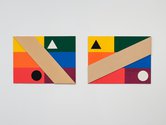
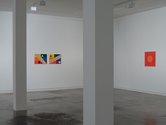
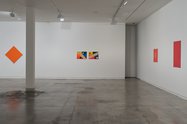
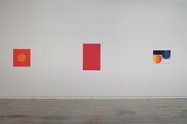
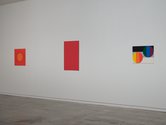


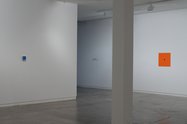
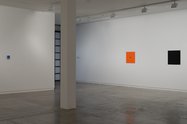
 Advertising in this column
Advertising in this column Two Rooms presents a program of residencies and projects
Two Rooms presents a program of residencies and projects



This Discussion has 0 comments.
Comment
Participate
Register to Participate.
Sign in
Sign in to an existing account.